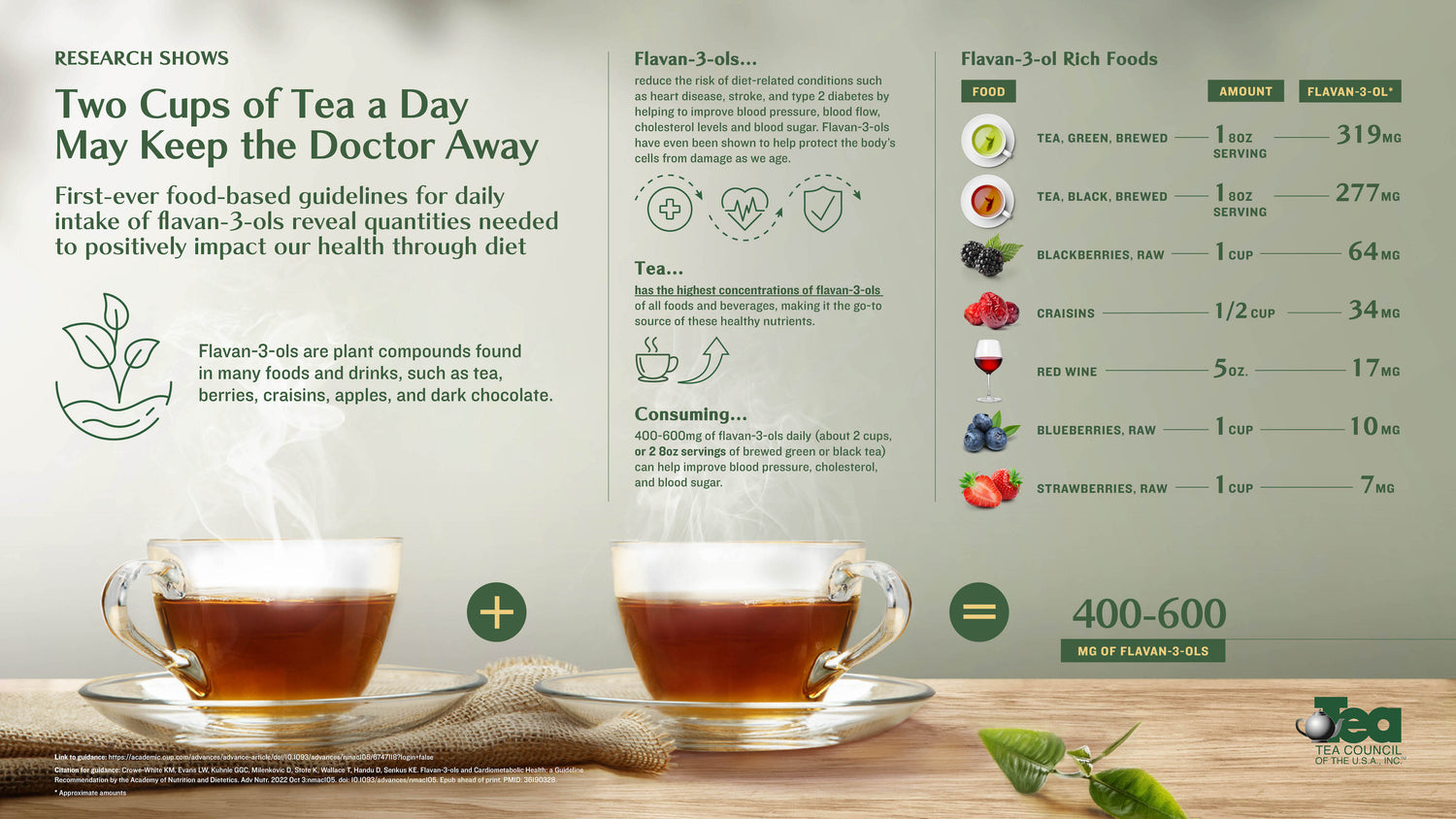New Research Shows Two Cups of Tea a Day May Keep the Doctor Away
First-ever food-based guidelines for daily intake of flavan-3-ols reveal quantities needed to positively impact our health through diet.
(New York, New York) – December 7, 2022: While scientific evidence has supported the health properties of tea’s bioactive compounds, there is now guidance on how much of these nutrients we need to consume for health benefits. New guidelines published in Advances in Nutrition have extrapolated data from published research to form dietary recommendations for flavan-3-ol intake. This research and guidance is the culmination of a collaboration between the Institute for the Advancement of Food and Nutrition Science, an international expert panel and The Academy of Nutrition and Dietetics to release recommendations for specific quantities of flavan-3-ols to consume daily to reap health benefits.
What Are Flavan-3-ols?
There’s something brewing in your tea you may not know about: flavan-3-ols. Data shows that consumption of 400-600mg of flavan-3-ols daily (about 2 cups of brewed green or black tea) can help improve blood pressure, cholesterol, and blood sugar. Flavan-3-ols are plant compounds found in many foods and drinks, such as tea, berries, craisins, apples, and dark chocolate. True teas – which include black, green, white, dark and oolong – have been found to have the highest concentrations of flavan-3-ols of all foods and beverages evaluated.
For decades, research has consistently demonstrated flavan-3-ols’ ability to help reduce the risk of diet-related conditions such as heart disease, stroke, and type 2 diabetes by helping to improve blood pressure, blood flow, cholesterol levels and blood sugar. Flavan-3-ols have even been shown to help protect the body’s cells from damage as we age.
Flavan-3-ols & Diet-Related Disease
These new guidelines could impact broader dietary recommendations and significantly improve the health of Americans. To establish these guidelines, data was evaluated from 157 randomized control trials and 15 cohort studies as part of a recently published systematic review and meta-analysis. When asked about the significance of the guidelines, lead researcher Kristi Crowe-White, PhD, RD explained “We know flavan-3-ols found in plant-foods can impact cardiometabolic health by helping to improve blood pressure, blood flow, cholesterol levels and blood sugar making our intake recommendations key to preventing, and improving, disease. Flavan-3-ol rich foods, such as teas, are accessible and affordable and can truly have positive effects on cardiometabolic health. These guidelines are a framework for broader dietary guidance and show the powerful impact food has on health.”
Diet-related diseases not only negatively impact the health of individuals, but our economy. Heart disease is the leading cause of death for men, women, and people of most racial and ethnic groups in the United States and costs the United States about $229 billion each year. (1,2) In addition, 37.3 million Americans (about 1 in 10) have diabetes, and 96 million American adults (more than 1 in 3) have prediabetes. (3) Diabetes is the seventh leading cause of death in the United States, and annual medical costs and lost work and wages totals an estimated $327 billion. (4)
Is Tea the Key?
As we look to improve our health and prevent disease through diet, it’s important to know which foods and beverages contain the highest amount of nutrients to reap the most benefits. True teas have been found to have the highest concentrations of flavan-3-ols of all foods and beverages evaluated.
“Teas such as green and black are flavan-3-ol powerhouses. It’s exciting something like tea, which so many people already consume and enjoy, and is accessible and affordable, can provide us with optimal amounts of flavan-3-ols” said Crowe-White. The newly issued guidance states there is moderate evidence supporting cardiometabolic protection from consuming 400-600mg of flavan-3-ols daily. Following these guidelines, research suggests health benefits can be seen from consuming about two, eight-ounce cups of green or black tea each day. Importantly, these guidelines are food-based recommendations, meaning the flavan-3-ols should be consumed through food and drink and are not applicable recommendations for flavan-3-ol supplements.
“Research has always shown that tea is an inherently healthy beverage, but with this groundbreaking guidance we now have actionable recommendations about how much tea should be consumed to see health benefits” says Peter Goggi, President of the Tea Association of the U.S.A. “By drinking just two cups of true tea each day people will be able to improve their health. Science shows tea is a key beverage to consume if you want to live a long, healthy life.”
About the Tea Council of the USA:
The Tea Council of the USA is a non-profit association that was formed in 1950 as a joint partnership between tea packers, importers and allied industries within the United States, and the major tea producing countries. It functions as the promotional arm of the tea industry with a primary goal of increasing overall awareness of tea by providing information about its many positive attributes. One of the Council's primary objectives is the dissemination of key scientific findings about tea to the public. The Tea Council does this in several ways including: funding scientific meetings to bring tea researchers from around the world together to share key information and identify next steps for future research projects; and working with health organizations and international scientists to disseminate information about potential positive health effects of tea consumption on a public level.
Shop this collection for the teas highest in Flavan-3-ol
1. Centers for Disease Control and Prevention, National Center for Health Statistics. About Multiple Cause of Death, 1999–2020. CDC WONDER Online Database website. Atlanta, GA: Centers for Disease Control and Prevention; 2022. Accessed February 21, 2022.
2. Agency for Healthcare Research and Quality. Medical Expenditure Panel Survey (MEPS): household component summary tables: medical conditions, United States. Accessed April 8, 2021.
3. The Centers for Disease Control and Prevention. The facts, stats, and impacts of diabetes. (2022, January 24). Retrieved from https://www.cdc.gov/diabetes/library/spotlights/diabetes-facts-stats.html
4. The Centers for Disease Control and Prevention. The facts, stats, and impacts of diabetes. (2022, January 24). Retrieved from https://www.cdc.gov/diabetes/library/spotlights/diabetes-facts-stats.html
















5 comments
Barbara Haymann-Diaz
Do decaf teas have the same amount of Flavan-3-ols in them as non-decaf teas?
Do decaf teas have the same amount of Flavan-3-ols in them as non-decaf teas?
Wanda
Thanks to a friend who gifted me your beautiful linen box of wonderful teas, I am a recent convert from coffee to tea!! Paris and celebration are my favorites as of now. However I am trying different ones and have given several gists to family and friends. Not only am I enjoying delicious tea but learning from your site as well! I.e. the article re: the sugarcane sachets!! Thank you so much for a delicious cup or two every morning…sometimes in the evening too!!
Thanks to a friend who gifted me your beautiful linen box of wonderful teas, I am a recent convert from coffee to tea!! Paris and celebration are my favorites as of now. However I am trying different ones and have given several gists to family and friends. Not only am I enjoying delicious tea but learning from your site as well! I.e. the article re: the sugarcane sachets!! Thank you so much for a delicious cup or two every morning…sometimes in the evening too!!
Tracy Sullivan
Thanks Mike! That was very interesting! I’m 79 and in great shape. Must. be all the tea I’ve had from you for years!
Thanks Mike! That was very interesting! I’m 79 and in great shape. Must. be all the tea I’ve had from you for years!
Kathy
Thank you for the informative article. I’ve known for quite awhile that drinking tea has healthful benefits. As always, I appreciate the tea updates.
Thank you for the informative article. I’ve known for quite awhile that drinking tea has healthful benefits. As always, I appreciate the tea updates.
Holly Durkin
Thank you for this article! I am sharing across my sphere of influence.
I have often had recommendations to drink more tea because of its health benefits without explaining the health benefits.
My daughter and I have enjoyed your teas for a number of years. In 2022 my husband found how refreshing Harney ice teas were after a day of work in the fields on our farm.
This spring, I am opening a Day Spa (Pre-Grand Opening in February) and will be featuring your teas in our lounge area! I hope we can work together on this.
Forever Grateful for Harney and Sons Tea!
Thank you for this article! I am sharing across my sphere of influence.
I have often had recommendations to drink more tea because of its health benefits without explaining the health benefits.
My daughter and I have enjoyed your teas for a number of years. In 2022 my husband found how refreshing Harney ice teas were after a day of work in the fields on our farm.
This spring, I am opening a Day Spa (Pre-Grand Opening in February) and will be featuring your teas in our lounge area! I hope we can work together on this.
Forever Grateful for Harney and Sons Tea!